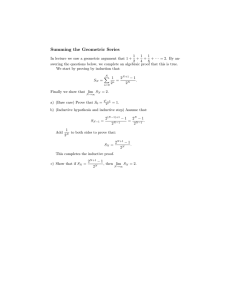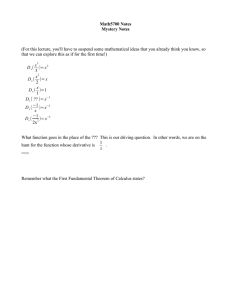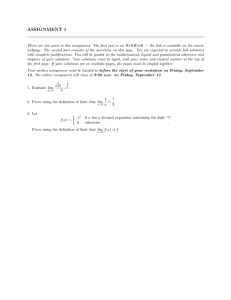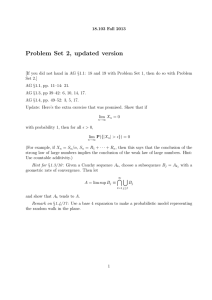Summing the Geometric Series
advertisement
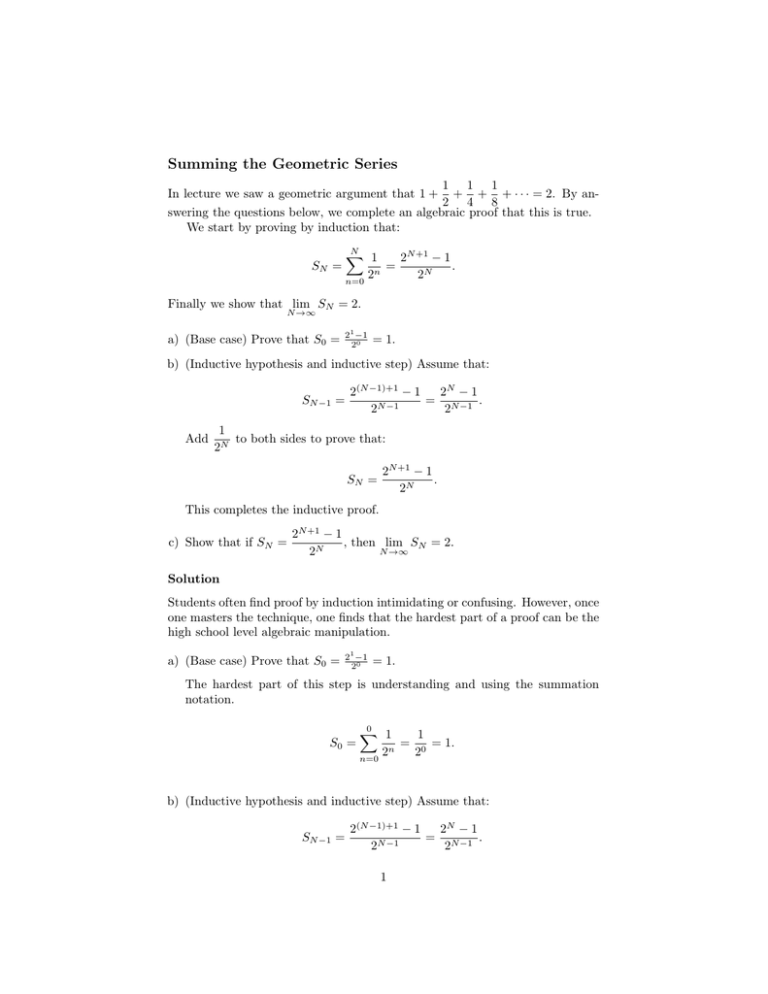
Summing the Geometric Series 1 1 1 In lecture we saw a geometric argument that 1 + + + + · · · = 2. By an­ 2 4 8 swering the questions below, we complete an algebraic proof that this is true. We start by proving by induction that: N � 1 2N +1 − 1 = . n 2 2N n=0 SN = Finally we show that lim SN = 2. N →∞ a) (Base case) Prove that S0 = 21 −1 20 = 1. b) (Inductive hypothesis and inductive step) Assume that: SN −1 = Add 2(N −1)+1 − 1 2N − 1 = . 2N −1 2N −1 1 to both sides to prove that: 2N SN = 2N +1 − 1 . 2N This completes the inductive proof. c) Show that if SN = 2N +1 − 1 , then lim SN = 2. N →∞ 2N Solution Students often find proof by induction intimidating or confusing. However, once one masters the technique, one finds that the hardest part of a proof can be the high school level algebraic manipulation. a) (Base case) Prove that S0 = 21 −1 20 = 1. The hardest part of this step is understanding and using the summation notation. S0 = 0 � 1 1 = 0 = 1. n 2 2 n=0 b) (Inductive hypothesis and inductive step) Assume that: SN −1 = 2(N −1)+1 − 1 2N − 1 = N −1 . N −1 2 2 1 1 to both sides to prove that: 2N 2N +1 − 1 SN = . 2N This completes the inductive proof. Add This step requires careful manipulation of rational expressions, but is other­ wise straightforward. We start with: SN −1 = 2N − 1 . 2N −1 Applying the definition of SN to the left hand side, we get: N −1 � 1 2n = 2N − 1 2N −1 1 1 + N 2n 2 = 2N − 1 1 + N 2N −1 2 n=0 Next we add 1 2N to both sides: N −1 � n=0 Expand the summation and then add to complete the proof. N −1 � 1 1 + N 2n 2 = 1 1 1 1 + 2 + · · · + N −1 + N 20 2 2 2 = SN = SN = n=0 2N − 1 1 + N 2N −1 2 2(2N − 1) 1 + N 2 · 2N −1 2 2N +1 − 2 1 + N N 2 2 2N +1 − 1 2N 2N +1 − 1 , then lim SN = 2. N →∞ 2N This is a straightforward evaluation of a limit. c) Show that if SN = lim SN N →∞ = = = = = 2N +1 − 1 N →∞ 2N � N +1 � 2 1 lim − N N →∞ 2N 2 � � 1 lim 2 − N N →∞ 2 1 2 − lim N N →∞ 2 2 lim 2 (dfn. of SN ) 1 1 1 1 2N +1 − 1 To summarize, we first proved that 0 + 2 + · · · + N −1 + N = . 2 2 2 2 2N Then we showed that as the number of terms in this sum approaches infinity, the value of the sum approaches 2. 3 MIT OpenCourseWare http://ocw.mit.edu 18.01SC Single Variable Calculus�� Fall 2010 �� For information about citing these materials or our Terms of Use, visit: http://ocw.mit.edu/terms.
